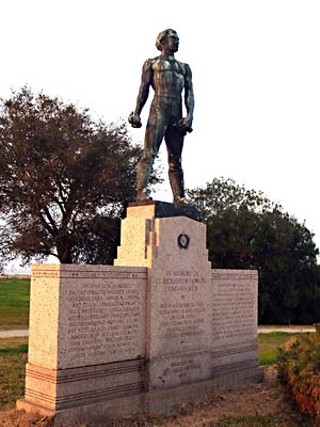Day Trips
The Battle of Sabine Pass is known as one of the greatest battles, yet it has been largely overshadowed by other Civil War engagements
By Gerald E. McLeod, Fri., Jan. 11, 2008

The Battle of Sabine Pass has gone down in military history as one of the greatest battles, yet it has been largely overshadowed by other engagements during the Civil War. As most Texas schoolchildren know, 43 Irish-Texans with six cannons repelled a Union invasion force of 6,000 and saved the state from occupation.
Today, the site where the rudimentary fort stood is commemorated with a historic park about 14 miles south of Port Arthur. Huge oceangoing vessels move vast amounts of goods into the Gulf of Mexico through the narrow pass that separates Texas and Louisiana.
From the outset of the Civil War, the federal army tried to choke off the South's economic capabilities by blockading the ports. Sabine Pass became one of the most notoriously successful smugglers' routes along the southern coast. Ships carrying lumber and cotton from East Texas and Louisiana hid on Sabine Lake before making a dash for open waters. Galveston might have been the state's biggest official port, but Sabine Pass was the busiest unofficial route for goods and people.
After several successes against southern shore batteries and the capture of Galveston, the U.S. Navy turned its attention to the Southeast Texas shipping channel in September 1863. The Union's battle plan was to steam up the Sabine Channel, land a small army, take control of the railroad between Houston and New Orleans, and then capture Houston. By occupying coastal Texas, the Union could control nearly the entire state.
The Confederate army had a much different plan. Concerned by rumors of a naval attack at Sabine Pass, military officials sent a Polish and a Swiss engineer to construct Fort Griffin two miles south of Sabine City. It was an excellent strategic location on a small hill on the otherwise flat marshland. The small fort's guns could cover the narrow channel that was divided by a large oyster reef. The bunker was manned by a group of Irish dockworkers lead by Lt. Dick Dowling, a 25-year-old Houston saloon keeper.
The rowdy Irish immigrants really didn't have a cause in the Civil War other than their love of a good fight. In fact, many of them deserted to the Union side when the overwhelming odds became obvious. Despite their barroom antics, the unit was an efficient artillery company. Before the battle began, they had practiced firing at markers placed around the reef.
The Union's navy's plans began unraveling almost from the beginning. It took hours to get the heavy ships over the sandbar at the mouth of the pass. By 3:30pm on Sept. 8, 1863, the gunboats were ready to begin the attack.
The USS Clifton slowly began the charge up the Texas side of the channel. Blinded by the sun and unable to gauge the accuracy of their cannon fire, most of the Union shells flew over the fort. The first ship to come into range of the fort's artillery was the USS Sachem, advancing up the Louisiana side of the channel, followed by the USS Arizona. The Irishmen's accuracy took out the boiler of the Sachem, leaving it disabled and blocking the right side of the oyster reef.
The Clifton kept advancing toward the fort until it ran aground a few hundred yards from the shore battery. The accuracy of the fort's guns soon forced the stuck skipper to raise the white flag. A transport ship following the Clifton saw the devastation and turned back rather than landing its troops according to plan.
According to Dowling's report, his gunners got off 137 shots during the 45-minute battle. His men captured two Union ships and 350 prisoners and routed the invasion without a casualty.
In 1971, the state purchased the site of Fort Griffin as a small park where a monument to Dowling and his men had been placed in 1936. There is no visible evidence of the Civil War fort at the park. Ammunition bunkers left over from World War II coastal batteries disturb the flat landscape. In 2005, Hurricane Rita destroyed many of the park's picnic tables and pavilions. The state Legislature transferred the property to the Texas Historical Commission in 2007.
The Sabine Pass Battleground Historic Site, south of Port Arthur on TX 87, is a tranquil place with no hint of the epic battle that took place here other than a monument to Dowling and his men. The shrill songs of birds mix with the clang of steel from oil-drilling platforms being constructed nearby. An occasional freighter passes where the oyster reef once blocked the channel. This is still an isolated corner of Texas, unconquered by the deeds of man.
The park is open daily during daylight hours. No services are provided at this time. There is no admission fee.
862nd in a series. Day Trips, Vol. 2, a book of "Day Trips" 101-200, is available for $8.95, plus $3.05 for shipping, handling, and tax. Mail to: Day Trips, PO Box 33284, South Austin, TX 78704.








